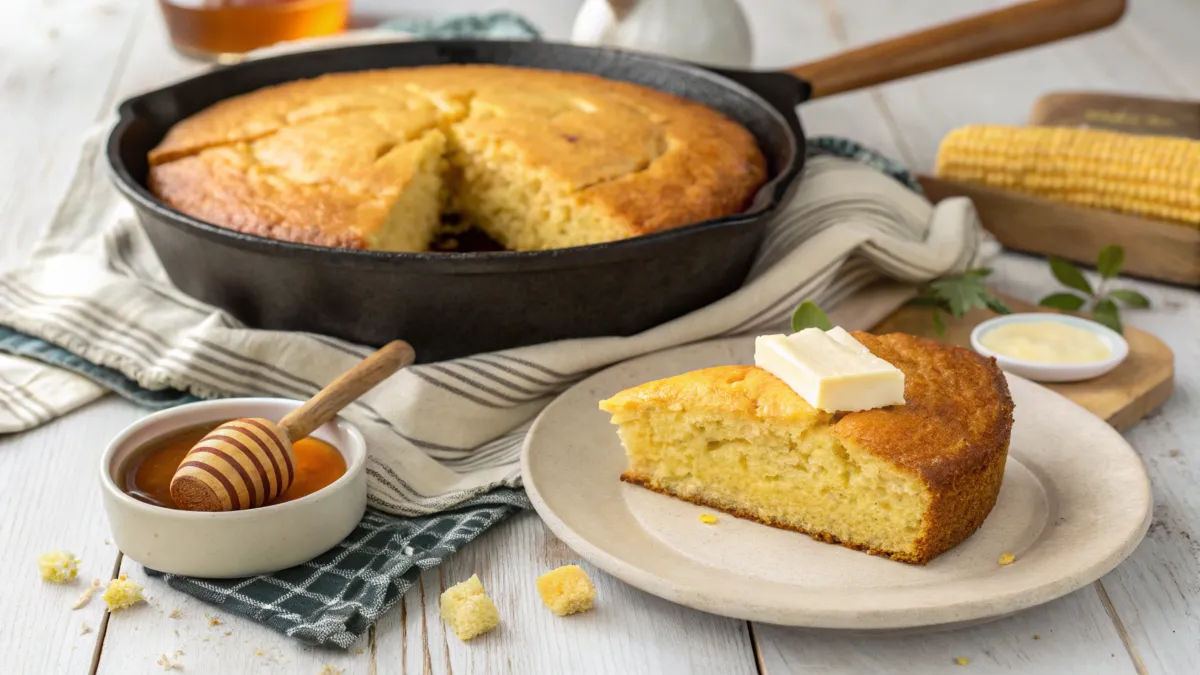Buttermilk cornbread recipe lovers know there’s nothing quite like the warm, golden comfort of a freshly baked skillet of cornbread. This classic Southern side dish has earned its place at the table for generations, thanks to its rich flavor, tender crumb, and nostalgic charm. Whether you’re serving it alongside a smoky Kansas City BBQ ribs platter or crumbling it into a savory chili, this buttermilk cornbread recipe delivers the perfect balance of moisture and fluff.
In this guide, you’ll discover the history behind this timeless dish, learn the essential ingredients that make a truly authentic buttermilk cornbread recipe, and pick up expert tips for achieving that golden, crispy edge every home cook craves. We’ll also show you how to pair it with dishes like a bold teriyaki glazed salmon, a fresh classic cucumber sandwich, or even creative meal ideas like the indulgent gooey grilled pizza cheewich.
Whether you’re baking for a weekday dinner or prepping for a holiday feast, this buttermilk cornbread recipe will be your new go-to. And if you’re looking for a sweet finish, why not follow it up with a festive treat like our Valentine’s mini donuts bouquet or sip on a creamy cookies and cream Frappuccino? Keep reading to master every step of this unbeatable buttermilk cornbread recipe and impress your guests with true Southern flavor.
Table of Contents
Buttermilk Cornbread
What is Buttermilk Cornbread?
Firstly, buttermilk cornbread is a classic bread made with a mix of cornmeal, flour, and buttermilk, giving it a rich and tangy flavor. Moreover, it’s soft on the inside with a slightly crisp crust. This recipe is a crowd-pleaser, whether you’re serving it at family dinners, holidays, or casual gatherings.
Why Use Buttermilk in Cornbread Recipes?
Secondly, buttermilk isn’t just a flavor booster; it’s a magic ingredient. In addition, the acidity in buttermilk reacts with baking soda to create tiny air bubbles, making your cornbread rise beautifully. It also adds a slight tang, balancing the sweetness or savoriness of the bread. Plus, it keeps the cornbread moist for longer.
Brief History of Cornbread in American Cuisine
Furthermore, cornbread traces its roots to Native American cuisine, where corn was a dietary staple. Over time, settlers in the South adapted traditional recipes to include ingredients like buttermilk and eggs. This variation became a cornerstone of Southern cooking, valued for its simplicity and versatility.
Additionally, cornbread’s popularity grew alongside Southern comfort food, and today, buttermilk cornbread recipes are cherished for their nostalgic and hearty qualities. Whether you like it sweet or savory, cornbread is a timeless dish that brings people together.
Ingredients for the Perfect Buttermilk Cornbread
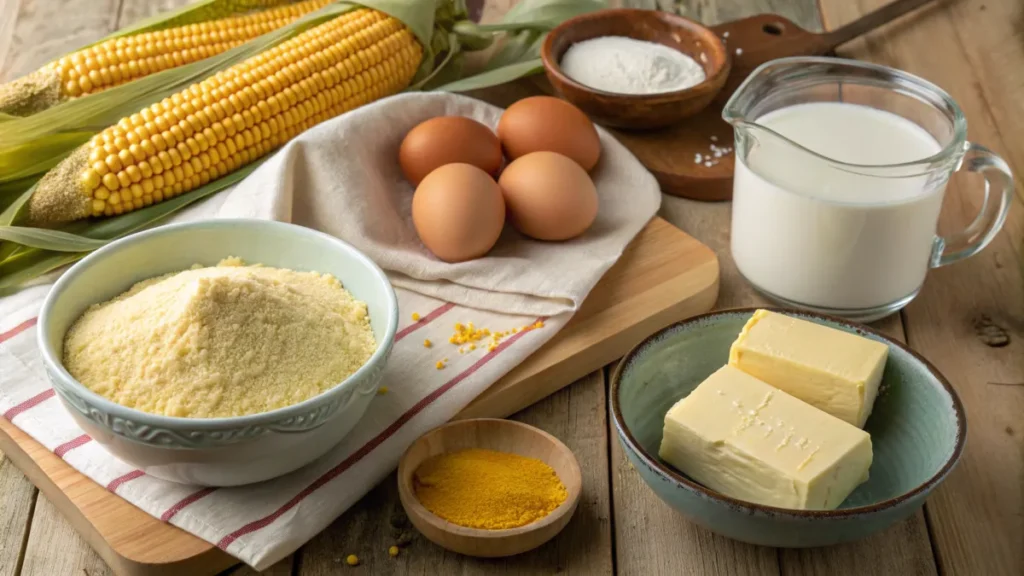
Essential Ingredients
The foundation of any great buttermilk cornbread recipe lies in its ingredients. Each plays a vital role in achieving the right flavor and texture.
- Cornmeal: This is the star of the recipe. Always opt for medium or fine-grind cornmeal to ensure a crumbly yet moist texture. Yellow cornmeal is a traditional choice for its rich color.
- Flour: A small amount of all-purpose flour balances the cornmeal and helps bind the bread. This ensures your cornbread isn’t too crumbly.
- Buttermilk: The heart of the recipe. Buttermilk adds tanginess and activates the baking soda for a light, fluffy texture.
- Baking Soda: It’s the leavening agent that works wonders when paired with buttermilk, creating a beautifully risen bread.
- Eggs: They act as a binder and add richness to the batter.
- Butter or Oil: These add moisture and a delicious buttery taste. Using melted butter gives your cornbread a rich flavor, but oil can make it slightly fluffier.
Optional Add-Ons for Flavor Variations
You can elevate your buttermilk cornbread recipe by adding ingredients that cater to different tastes.
- Cheddar Cheese: For a savory twist, mix shredded cheddar into the batter or sprinkle it on top.
- Jalapeños: Want a bit of heat? Add diced jalapeños for a spicy kick.
- Honey: A drizzle of honey adds a natural sweetness, complementing the tanginess of buttermilk.
Tools and Preparation Tips
Essential Kitchen Tools
Preparing a flawless buttermilk cornbread recipe requires just a few basic tools, but the right ones can make a big difference.
- Cast Iron Skillet: A must for achieving that signature golden crust. Preheating the skillet before adding the batter ensures an evenly cooked cornbread with a crisp exterior.
- Mixing Bowls: Use separate bowls for wet and dry ingredients. This makes combining them easier and prevents overmixing.
- Measuring Cups and Spoons: Precise measurements lead to consistent results. Don’t eyeball—especially with baking!
Preparation Tips for a Perfect Crust
Small changes in preparation can make or break your cornbread.
- Preheating the Skillet: Always preheat the skillet in the oven. Adding batter to a hot skillet helps create a crisp, golden crust.
- Greasing the Skillet: Generously grease your skillet with butter or oil to prevent sticking and add extra flavor.
- Mixing the Batter: Avoid overmixing. Stir the wet and dry ingredients just until combined to keep the cornbread tender.
Step-by-Step Recipe for Buttermilk Cornbread
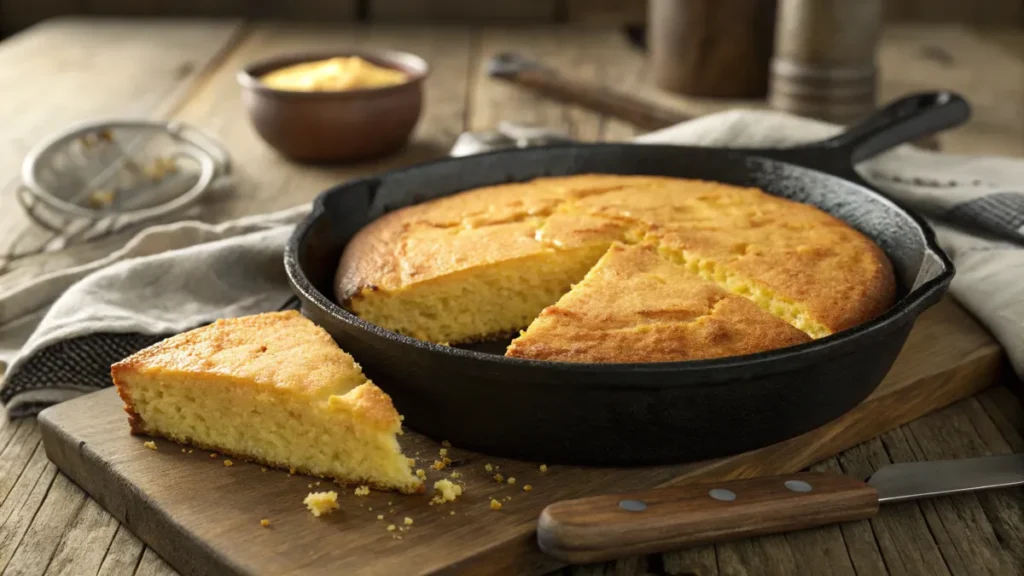
Preparing the Ingredients
Before you dive in, gather all your ingredients and tools. This step keeps your process smooth and stress-free. Start by preheating your oven to 400°F (204°C). If you’re using a cast iron skillet, place it in the oven to heat as well.
Next, measure your dry ingredients: cornmeal, flour, baking soda, and a pinch of salt. Mix them in a large bowl. In another bowl, whisk the wet ingredients: buttermilk, eggs, and melted butter. Combining these separately ensures even distribution when you mix them together.
Mixing the Batter
Now, slowly add the wet mixture to the dry ingredients. Stir gently until just combined. Avoid overmixing it’s okay if a few lumps remain. The batter should be slightly thick but pourable.
Baking Instructions
Carefully remove the preheated skillet from the oven and grease it with butter or oil. Pour the batter into the hot skillet and spread it evenly. Bake for about 20–25 minutes, or until the top is golden brown and a toothpick inserted in the center comes out clean.
Let the cornbread cool for 10 minutes before slicing. This makes it easier to cut and keeps it from crumbling too much.
Common Mistakes and How to Avoid Them
Overmixing the Batter
One of the most common pitfalls when making a buttermilk cornbread recipe is overmixing. Stirring the batter too much can lead to dense, chewy bread instead of a light and fluffy texture. Always mix just until the ingredients are combined.
Using Cold Ingredients
Cold ingredients can prevent the batter from blending properly. For best results, let your buttermilk, eggs, and butter come to room temperature before mixing. This small step makes a big difference in texture.
Skipping the Preheated Skillet
Skipping the preheated skillet can result in a soggy bottom and uneven cooking. Heating the skillet before pouring in the batter creates the crispy, golden crust that makes buttermilk cornbread so irresistible.
Serving Suggestions for Buttermilk Cornbread
Best Pairings
Buttermilk cornbread is a versatile side dish that pairs well with many meals. Its slightly tangy flavor complements hearty dishes like soups, stews, and chili. A steaming bowl of beef stew or a rich pot of gumbo becomes even more satisfying with a warm slice of cornbread.
For a Southern classic, serve your cornbread with fried chicken or barbecue ribs. The crispy crust and soft crumb of the cornbread balance the smoky, savory flavors perfectly. Don’t forget to add a pat of butter on top for an extra touch of indulgence.
Here’s a natural, SEO-optimized internal linking paragraph you can include near the end or within a section of your Buttermilk Cornbread article to boost engagement and time on site:
To complete your Southern-style feast, pair this golden buttermilk cornbread with hearty mains like our savory teriyaki salmon bowl or sweet-and-sticky teriyaki glazed salmon. Planning a backyard cookout? Don’t miss the smoky perfection of our Kansas City BBQ ribs.
Let me know if you’d like a version tailored for the middle or sidebar of the article instead.
Serving Warm vs. Room Temperature
Cornbread is best served warm, straight from the oven. The heat enhances its buttery aroma and makes the crumb extra tender. However, if you need to serve it later, don’t worry! Room temperature cornbread still tastes amazing.
To reheat, simply pop it in the oven at 350°F (175°C) for about 10 minutes. This method revives its freshness and keeps the crust crispy. Whether warm or cool, cornbread is sure to steal the show on your table.
For something fun and cheesy, the gooey grilled pizza cheewich is a crowd-pleaser, while the refreshing classic cucumber sandwich makes a perfect afternoon bite. And if you’ve got a sweet tooth, surprise someone with a festive Valentine’s mini donuts bouquet or treat yourself to our chilled, creamy cookies and cream Frappuccino both irresistibly delightful.
Nutritional Information
Calories and Macronutrients
A single slice of buttermilk cornbread offers a balance of carbohydrates, fats, and proteins. On average, one slice contains about 180–200 calories, depending on the recipe and add-ins. It’s a hearty choice that provides quick energy, thanks to the cornmeal and buttermilk.
Cornbread is naturally rich in fiber, making it a satisfying side that keeps you full. Adding ingredients like jalapeños or cheese increases the flavor without a significant change in calories.
Making a Healthier Buttermilk Cornbread Recipe
Creating a healthier buttermilk cornbread recipe doesn’t mean sacrificing flavor. With a few smart swaps, you can enjoy all the comfort of traditional cornbread with better nutrition. Try using whole wheat flour instead of white flour for added fiber and nutrients. For a creamy texture with less fat, substitute Greek yogurt in place of butter it’s a trick we also love in lighter dishes like our teriyaki salmon bowl.
Cutting back on sugar? A drizzle of honey or maple syrup adds natural sweetness that pairs perfectly with any buttermilk cornbread recipe. Need it gluten-free? Almond or oat flour makes an excellent base, just like we use in our better-for-you twists on baked goods such as the Valentine’s mini donuts bouquet. For a full balanced meal, serve this healthier version alongside a classic cucumber sandwich or enjoy it with the bold flavors of our gooey grilled pizza cheewich.
These simple upgrades let you indulge in a wholesome buttermilk cornbread recipe that’s just as satisfying without the guilt.
Frequently Asked Questions (FAQs)
Can I Substitute Buttermilk with Regular Milk?
While buttermilk is a key ingredient in the classic buttermilk cornbread recipe, you can substitute it in a pinch. If you don’t have buttermilk on hand, mix one cup of regular milk with one tablespoon of lemon juice or white vinegar. Let it sit for 5–10 minutes, and you’ll have a tangy buttermilk alternative.
Keep in mind, though, that the flavor and texture may vary slightly. Buttermilk helps create a fluffy texture and adds a subtle tang that regular milk can’t fully replicate.
What Can I Use Instead of a Cast Iron Skillet?
A cast iron skillet is ideal for achieving that crispy crust, but it’s not the only option. You can use a glass or metal baking dish if needed. Just be sure to grease it well to prevent sticking.
For a unique twist, try baking your cornbread in muffin tins. This method creates individual servings with slightly more crust per piece. Regardless of the pan you choose, the buttermilk cornbread recipe will still be delicious.
How Do I Store Leftover Cornbread?
Leftover cornbread can be stored in an airtight container at room temperature for up to two days. For longer storage, keep it in the fridge, where it will stay fresh for about a week.
If you want to save it for later, freeze the cornbread in a sealed bag or container for up to three months. When you’re ready to enjoy it again, reheat it in the oven to restore its warm, fluffy texture.
A Quick Comparison Table of Recipe Variations
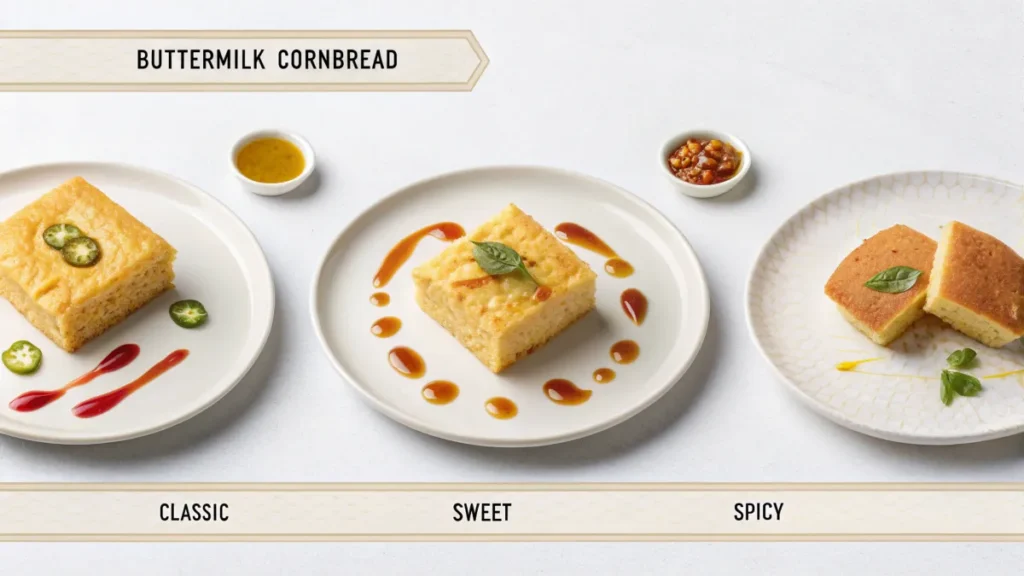
Cornbread comes in many delicious forms, and each variation offers its own unique twist. This table compares some popular styles to help you choose the perfect option for your meal.
| Variation | Key Ingredients | Texture | Sweetness Level | Best For |
|---|---|---|---|---|
| Classic Buttermilk | Cornmeal, buttermilk | Crumbly | Low | Everyday meals |
| Sweet Cornbread | Added sugar, honey | Moist | High | Desserts or brunch |
| Spicy Jalapeño | Jalapeños, cheddar | Dense | Low | Spicy food lovers |
| Gluten-Free Cornbread | Almond or oat flour | Tender | Moderate | Special diets |
| Honey Butter Cornbread | Honey, butter glaze | Soft | Moderate-high | Sweet and savory fans |
This variety showcases how adaptable the buttermilk cornbread recipe can be. Whether you prefer it savory, sweet, or spicy, there’s a version to suit every taste.
For another twist on a Southern classic, try this sweet potato cornbread recipe for a moist and flavorful alternative, or explore these top-rated cornbread recipes for more inspiration.”
Why Buttermilk Is Better for Cornbread
When it comes to baking the perfect buttermilk cornbread recipe, buttermilk easily outshines regular milk. Its tangy flavor adds a signature depth that plain milk just can’t deliver. More importantly, the acidity in buttermilk reacts with baking soda, producing tiny air bubbles that give your buttermilk cornbread recipe its beautifully light and fluffy texture.
Buttermilk also helps retain moisture, meaning your cornbread stays soft and fresh for days perfect for make-ahead meals or leftovers. This advantage makes it the ideal base not only for traditional cornbread but also for modern variations served alongside dishes like our bold and flavorful teriyaki glazed salmon or a hearty Kansas City BBQ ribs dinner. For anyone aiming to master a truly unforgettable buttermilk cornbread recipe, starting with quality buttermilk is the key to success.
Southern cornbread is different from regular cornbread.
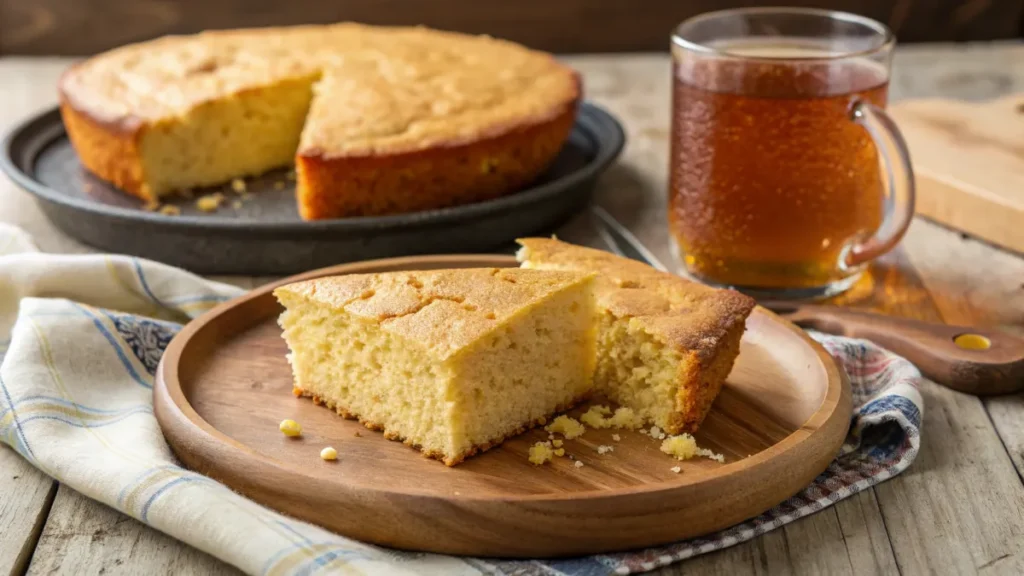
Southern Cornbread vs. Regular Cornbread
When comparing Southern cornbread to other varieties, the differences are both flavorful and textural. Southern-style cornbread is typically savory, using less sugar and more cornmeal, resulting in a denser, more rustic texture. Traditional recipes often incorporate bacon drippings, adding a rich, smoky flavor that complements dishes like our Kansas City BBQ ribs or teriyaki glazed salmon. This style of cornbread pairs perfectly with hearty meals, making it a staple in Southern cuisine.
In contrast, other cornbread recipes tend to be sweeter and more cake-like, incorporating more flour and sugar. These versions are often enjoyed as a dessert or alongside lighter fare, such as our classic cucumber sandwich. Whether you prefer the savory depth of Southern cornbread or the sweet, fluffy texture of other styles, understanding these differences can enhance your appreciation and execution of the perfect buttermilk cornbread recipe.
Dolly Parton’s Buttermilk Cornbread Recipe – A Southern Favorite
Making a classic buttermilk cornbread recipe like Dolly Parton’s is simple, nostalgic, and incredibly satisfying. Start with basic pantry ingredients: cornmeal, flour, baking powder, and salt for your dry base. Then add eggs and tangy buttermilk to form a rich, moist batter. Some variations include a scoop of creamed corn for extra sweetness and texture perfect for a soft crumb and golden crust.
Once mixed, pour your batter into a hot, greased skillet and bake until beautifully golden brown. This warm, buttery buttermilk cornbread recipe is ideal with hearty mains like Kansas City BBQ ribs or paired with something lighter like our classic cucumber sandwich. For a creative twist, try it with a cheesy favorite like the gooey grilled pizza cheewich, or serve as a cozy companion to a flavorful teriyaki salmon bowl.
Whether you’re preparing breakfast, dinner, or something in between, this easy buttermilk cornbread recipe brings timeless Southern flavor to every bite, and it stays moist and delicious for days.
The Importance of Eggs in Your Buttermilk Cornbread Recipe
Eggs are a key ingredient in any buttermilk cornbread recipe because they serve as the essential binder that keeps your cornbread from falling apart. Without them, even the best buttermilk cornbread recipe may turn out dry, crumbly, and structurally weak. Eggs help hold the cornmeal, flour, and other components together, ensuring every slice stays intact. They also contribute to the overall moisture, giving your cornbread that soft, cake-like texture we all love.
If you’re experimenting with variations perhaps pairing your cornbread with a cozy creamy mushroom garlic chicken Alfredo or serving it alongside southern dumplings you’ll appreciate how eggs help balance the texture. They’re a small but mighty ingredient that guarantees your buttermilk cornbread recipe comes out moist, flavorful, and perfectly sliceable every time.
Conclusion
Buttermilk cornbread is a timeless recipe that brings warmth and comfort to any table. From its rich history in Southern cuisine to its endless variations, this dish is as versatile as it is delicious. Whether you prefer it classic, sweet, or spicy, there’s a buttermilk cornbread recipe for everyone.
By following this guide, you’ll master the art of making cornbread with ease. From choosing the right ingredients to perfecting your crust in a cast iron skillet, every step contributes to a dish that’s sure to impress. Pair it with your favorite meals or enjoy it on its own there’s no wrong way to savor this classic bread.
So, preheat your oven, gather your ingredients, and get ready to create the perfect buttermilk cornbread. Share it with family and friends, and watch as it becomes a beloved staple in your home.
For more delicious recipes and culinary inspiration, be sure to explore our other recipe guides. Happy baking!

